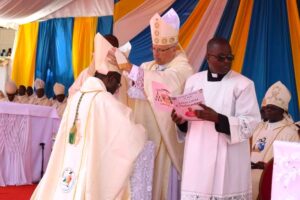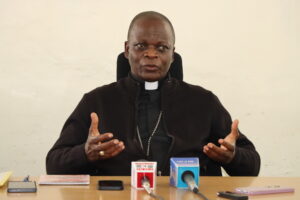KENYA: Human Dignity – Participation of Women in Integral Human Development. A Study Among the Kalenjin in the Catholic Diocese of Eldoret, Kenya

Robert Niewiadomski and Diane Rodríguez
BOOK REVIEW
Author: Veronica Jemanyur Rop
Place of publication: Hamburg, Germany
Publisher: Verlag Dr. Kovac GmbH, ISBN 978-3-339-11442-6
Year of publication: 2020
Price: US$ 116.63 (paperback)
Number of pages in the book: 353
Keywords: women education in Africa, integral human development, moral theology, human dignity, Kenya
The book by Sister Veronica Jemanyur Rop, a Catholic theologian from the Assumption Sisters of Eldoret, explores Catholic education from the Black female perspective, drawing inspiration from a favorite African proverb: “To educate a woman is to educate the whole village.” Her well-researched project integrates educational study with moral theology to create compelling advocacy for girls oppressed by systemic patriarchal structures and cultural customs of a traditional Kalenjin society in Kenya.
Growing up in the polygamous Kalenjin community, she endured patriarchal dominance, interfering with her intellectual growth as a woman (Rop, 2021). Based on Rop’s doctoral dissertation, the book was a significant milestone in her academic rite of passage and re-examining her cultural heritage. She took on the ambitious task of providing a novel and a cohesive women advocacy project within the constraints of Catholic doctrine and practical realities of the Kalenjin community that she serves. Rop provided a nuanced account of her version of social justice relating to African women while navigating the precarious intersection of traditional Catholic teaching and progressive movements, such as liberation theology or Paulo Freire’s (2017) educational philosophy.
Rop’s analysis painstakingly enumerates various forms of oppression in the traditional Kalenjin community, focusing on mechanisms that underpin gender bias and discrimination: denial of legal standing in traditional community courts, forfeiture of property ownership, intimidation and physical violence, and wife-beating (p. 76-79). Rop describes the status of women in the Kalenjin community as paradoxical. On the one hand, they have exalted roles as nurturers of families, wives, and mothers. On the other hand, their status is comparable to that of a minor. They customarily remain under the guardianship of a male figure (pp. 74-75). The exaltation of their social roles as mothers and wives reinforces their subservient position in the patriarchy as mere stewards of procreation. Rop also interrogates the origins of gender power imbalance in this community and concludes that the abuse of women is an actual phenomenon and stems from endemic patriarchal structures predating colonial influences (pp. 84-86).

of the Assumption Sisters of Eldoret
Rop’s understanding of social justice as challenging structural injustices is most evident in her discussion of progressive theologians. Referring to Donal Dorr (1992), Rop writes, “Given the importance of the dignity of a person, a preferential option for the poor becomes not only important but a principle that ought to be taught to the Kalenjin community not only as a preferential option for the poor but also for the women” (p.253). Further, Rop elaborates that a preferential option for the poor means siding with the oppressed while at the same time challenging the rich, the oppressors (p.253). She also agrees with Dorr (1992) that siding with the poor requires a commitment to confront structural injustices (p.253). Similarly, in the section on justice, Rop states that justice as participation “requires that we go deep into the root causes of causes of injustices, address them and hold those accountable” (p. 255).
Moreover, Rop embraces the central tenets of liberation theology as articulated by one of its most prominent proponents, Gustavo Gutierrez (1988). As Rop explains, “God identifies with the oppressed. Like Jesus Christ, the liberator, and promoter of women’s dignity, Christians are called to work for the liberation of the oppressed” (p. 259). She further proposes that her diocese uses liberation theology to promote the dignity of Kalenjin women, gender equality, and respect for the environment (p. 259). Finally, liberation theology could provide the foundation for protecting women from oppressive cultural practices, such as female genital mutilation (p. 260). And for men, liberation theology could become a remedy to set them free from the patriarchal mindset (p. 260).
We can read Rop’s book as a doctoral dissertation. We can judge it on its merits, methods, use of evidence, conclusions, and limitations. We can ask whether she met the objectives and thoroughly answered research questions. We can also question whether her endeavor was coherent. Undoubtedly, we can find plenty of room for improvement. There is, however, another way to read this book that we think is more exciting. At a deeper level, it is a narrative about a person who grapples with a set of issues affecting her community in a very concrete way at a particular time. She copes with the problems she faces with the instruments that are available to her. And she is courageous, audacious, and visionary as she toils to build a most equitable and just society.
At that level, the book may be of interest to various readers. Educational scholars may find it helpful in investigating the realities of women’s education in traditional African communities. In particular, the book is an account of the struggle to negotiate local customs and beliefs about gender with the need to promote transformative education for future female community leaders. Sociologists could read it as an account of the role of Christian religious thinking in changing the societal role of women and, in turn, transforming traditional societies. Theologians might find it fascinating as a window into forming new ways of thinking among African Catholics. It shows how religious women try to negotiate liberation theology to address social and gender injustices with a specific interpretation of traditional new feminism to account for their more conservative cultural customs. Furthermore, anyone interested in strategies for how change occurs within traditional communities to advance social justice could find this book engaging.
Rop’s book affirms the vitality and agency of African religious women who reinterpret Catholic social teaching and theology to confront women’s oppression and promote social justice in their native communities. There is also no doubt that, in their pursuit, they struggle to carve out space for progressive advocacy within the bounds of the Church’s doctrine. Above all, the book is also a testament to the author’s unwavering conviction that it is impossible to achieve human dignity without women’s empowerment and liberation through education.


